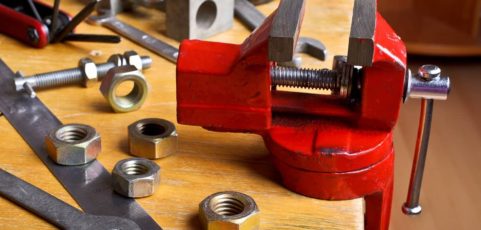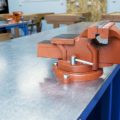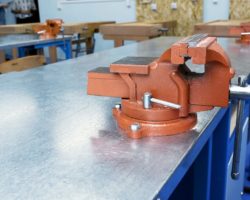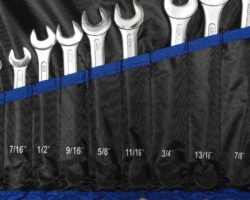If you are into DIY or you are a home workshop owner, then you know that the key to success is in having the right equipment. While dealing with wood and metal materials can be quite fun, it is risky. Unless you take certain precautions, the chance of injuring yourself is quite high. That is why investing in certain products such as a medium/heavy-duty bench vise is a must.
Considering that there are many different models of this product, choosing an adequate one depends on your budget as well as the capacity that you need for working tasks. While 5,000 lbs of clamping force may be enough for medium to small shaping, you will have to look for above 6,000 lbs when it comes to heavy-duty work. The primary purpose of a bench vise is to hold a specific material in its place while you saw your way through it.
Bearing this in mind, it is the jaws and the rotatable base of the bench vise that play the most important role. The purpose of this article will be to educate you on how bench vises work and give you a few tips related to properly mounting one. So what are you waiting for? Let’s get right to it and see the answers to these issues.
The Different Uses Of A Bench Vise
Before we get into how to mount a bench vise and what are the features of a high-quality model, we want to discuss the numerous uses of this product. As you might know, it is an essential tool in carpentry or metalworking projects, as the bottom and top jaw (along with a swivel base) create a holding system that stabilizes the material that you are working on.
In order for it to take place, you need to bolt the vise to an adequate bench temporarily or permanently, depending on the model that you are dealing with. Now, given the versatile uses of this product, it is time to go ahead and consider the most important instances where you may find yourself using your mounted bench vise for.
Using a saw
One of the most common purposes for a bench vise is to hold wood or metal in place while you are sawing it through. While it is not uncommon that people use their free hand to stabilize the material, this option is much more convenient and certainly reduces the chance of grave injury. It also improves your overall accuracy.
Drilling
As someone who is starting a home workshop, you are probably aware that there will be a lot of drilling involved. It is essential for creating electrical fittings or holes in wood and metal materials. Therefore, if you are not the most experienced with a drill, but you need to achieve perfect results, setting it onto a bench vise can go a long way. This is a great option for beginners that are yet to get comfortable with power drilling and also for those who want to reduce the effort they put into positioning by placing trust in a bench vise instead.
Working with wood
As we have mentioned above, a bench vise is most common for people who are in the carpentry business and with wood being the primary material that they are working with. Instead of placing heavy objects that will hold wood piece together while the glue takes its time, you will be able to adjust a bench vise and ensure proper positioning of the jaws that will hold the wood for how long it is needed without the risk of it becoming damaged or you being injured.
The biggest benefit of a bench vise is that not only will it keep that the wood object immovable, it will also contribute to the drying process and ensure that it remains in perfect shape. Also, you can use the mounted vise to hold the wood in place while you are taking any stubborn nails out.
Working with metal
Apart from the fact that a bench vise can be efficiently used for bending an iron rod, it will also allow you to comfortably cut through one side of metal while keeping the other one firmly in place. This is what makes it a worthy investment. Much like working with wood, a bench contributes to the overall stability and safety of your metalworking project.
Cutting an electrical conduit
Whether you are a DIY enthusiast or a craftsman cutting into an electrical conduit, it is something that requires optimal safety and what better product to ensure that than a bench vise. In order to get the most out of the purpose, you would want to bend the conduit carefully. Get it in between the jaws, slowly tightening the main screw, but make sure that the grip is not too tight and thus protect the conduit from damage.
Use as a Workbench
One of the most common ways to utilize a bench vise that you have invested in is to use it as a workbench. As long as it is compliant with the material and size that you are working with, you are good to go!
Removing a bearing
Much like we have mentioned above, a bench vice is a long-term investment that will significantly cut the costs of the other tools needed. Thus, if you don’t have a puller on hand, using the vise to remove a bearing can be quickly done. The main idea is to tightly fix the armature in the bench vise while leaving the bearing to stick out. Once you have one, apply equal weight on both the back and the front side and watch as the bearing flies off.
Sanding
Whether we are talking about painting or coating, you can efficiently utilize a bench vise to finish the task and give the smooth material a perfect sanding job.
Cracking a nut
You can simply have some fun and save yourself the effort of cracking nuts by using a hammer or even nothing but your hands. Use the area in between the vise to place a nut and slowly tighten it until it cracks.
What To Stay Away From
Now that we have discussed the few purposes of a bench vise, it is time to move on and mention a few things that you might as well stay away from. First and foremost, you should never be welding your vise or using the vise to weld metal. This only increases the chance of injury or damaging the surface you are working on, which is not something that you want. Along with that, never apply too much pressure on jaw corners or cut into them.
The most important precaution is that you should consider the specifications of your vise and use it accordingly. What this means is that you shouldn’t place a heavy metal on a light-duty model. Also, away consider the jaw opening and width before putting it to use. If you notice that the bench vise has any kind of cracks in the jaws or anvil working surface, you should put it away and ask for a replacement or search for a new one.
How To Properly Mount A Bench Vise
While mounting a bench vise is not something that should be too challenging, there are a few tips on how to do it in record time and with the lowest risk. What you should know before starting is that while most vises are placed on the corner of a table, there are those centered as well. Therefore, depending on the model that you are using, decide on the positioning before getting on to the mounting work.
First and foremost, you should make sure that all the tools and necessary materials are by your side, including bolts, washers, lock, and nuts, as well as a pencil, drill, sockets, bits, and a few wrenches!
Before you get into drilling, you should measure out the mounting holes by placing your vise wherever you will want it to be. Mark the holes with a pencil; in case there is a template that you are using make sure to line it up properly with a base. Once you have done that, it is time to move on and drill out the holes that you have just marked. Be careful with the pressure and apply as much as is needed while trying to prevent splinters from flying around everywhere.
Pick out a couple of washers and see if they fit the holes that you have just drilled. If not, you can optionally use a tool such as the metal file/grinder to ensure a better fit. Now that you have prepared the washers it is time to pick up your vise and place it over the mounting holes (aligning the base with the holes).
Place the bolts into the mounting holes and support it with a washer, locks and the nut on the underside of the vise. Once you have hand-tightened the bolts, it is time to use a socket to ensure an optimal fit. The key is that the bolts are neither too loose nor too tight, as this can affect the overall performance of the vise!
Different Type Of Bench Vises
There are a couple of different bench vises, including metalworking, pipe and woodworking vises. Out of all, the most important is the differentiation of woodworking visas. Here we have a heavy-duty vise that is highlighted by replacement jaws, a 360-degree swivel base, as well as a huge clamping force that is usually over 6,000 lbs.
A bench vise of this type is exceptionally sturdy and made out of cast iron. Much like the heavy-duty models, medium-duty woodworking vises usually feature a smooth anvil working surface and at least a 240-rotatable base that will contribute to the overall positioning and stability of working with a wood metal!
Anatomy Of A Bench Vise
Looking at the anatomy of a bench vise, there are a few significant components that highlight every high-quality product. The dynamic jaw is responsible for relieving and adding clamping pressure to a material. On the other hand, the static jaw is the one that is mounted to a table and is usually the heavier of the two jaws.
The threaded main screw goes through a dynamic jaw and is responsible for keeping it either open or closed. Last but not least, the handle that has the role of matching the clamping power and contributing to the adjusting feature!
Our Personal Favorite
DeWalt DXCMBV6 Bench Vise
Considering everything that we have mentioned above when it comes to mounting a bench vise, including the critical features of a proper bench vise, we highlight this DeWalt model as our personal favorite, and this is for many reasons.
With a swivel base that is rotatable up to 120 degrees, as well as a clamping force of over 600 lbs, it is a worthy investment that any home workshop owner will not regret! You will be able to complete both work tasks and home projects with ease using this DeWalt bench vise.
Conclusion
We started this article asking a simple question - Mounting a Bench Vise: How to Do It? Well, we do hope that this article has contributed to your overall understanding of how a bench vise works. There is no doubt that investing in a woodworking/metalworking bench vise can be worthy in a few different aspects, and we looked at quite a few of these a bit earlier in the article.
Once you have decided on the model that you need, depending on the material that you are working with, as well as your budget, follow our mounting tips and proceed to have a lot of fun! You will be able to complete many projects with a mounted bench vise, which will offer you stability and strength. In fact, with your mounted bench vise, you can say goodbye to wood that has been cut incorrectly or metal poles slipping as you file them.











